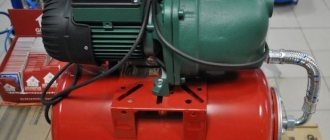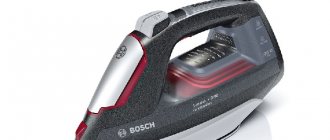Compare - identify the main differences
Electric and gasoline saws have almost the same cutting headset and operating principle. The saw chain slides along the ellipse of the bar, and the wood is cut by sharp teeth made of special alloys.
The difference is in the drive. Electro are driven by electric motors and consume electricity. The gasoline engine has a two-stroke internal combustion engine running on gasoline as its power plant. But this difference leads to the fact that these two units differ markedly in their properties in practical work.
In addition to the difference in energy sources, gas and electric saws have big differences in power characteristics.
As can be seen from the photo, on the left is an electric motor with a winding and an armature, and on the right is an internal combustion engine: piston, cylinder, crankshaft, etc.
The maximum power of electric chain saws is up to 2.5 kW. It is almost impossible to install a more powerful engine on such saws for the following reasons:
- The power saw becomes heavy and cumbersome.
- An electric motor with a power of about 5 kW requires a separate powerful cable and connection sockets. When starting, the electric motor, unlike electric stoves and heating elements, takes 3 times the rated power. That is, a 5 kW motor is 15 kW. All wiring and circuit breakers must be designed for this power.
Two-stroke internal combustion engines of powerful chainsaw models can develop power up to 6 kW.
There is a big difference in the speed indicators:
- An electric motor of 3000 rpm is already considered high-speed.
- The number of maximum (for all gas) rpm of the internal combustion engine on different models is from 12,000 to 15,000.
Such a difference in speed does not mean that the chain on an electric saw spins 4-5 times slower than at maximum on a chainsaw. Low speeds are partially mitigated by a higher gear ratio than chainsaws.
As a result, the electric saw turns the chain only 20-40% slower than a saw with an internal combustion engine. But, according to the laws of physics, while gaining speed due to a higher gear, the electric saw loses power.
Therefore, a consumer who replaces a 1.8 kW chainsaw with an electric saw of the same power will be disappointed by the poor performance precisely because of the low number of revolutions.
Chainsaw device. Visually there is practically no difference from the electric one.
There are fundamental differences in the drive design. Chainsaws have clutches. Therefore, the chain of a chainsaw running at idle speed does not rotate. Electric saws do not have clutches. The movement of the chain begins immediately after the soft start button is turned on.
The bar fastening and chain tensioning systems differ. On electric saws they are keyless. On most models of chainsaws, the tire is tightened in a more proven way, with nuts using a wrench. The tightening force of this type is visually controlled and is more reliable.
Oil pumps for supplying lubricant to the saw set operate on the same principle in both versions. Sometimes electric saws have pumps exactly the same as those on chainsaws.
Electric chain saw device
There is a difference in the layout of the mechanisms and the location of the center of gravity. All chainsaw models are thoughtfully balanced to ensure a comfortable grip. As a result, when lifted by the handle, all chainsaws are effortlessly in the working position, the tire or rear end does not hang down.
Holding a power saw in your hands requires more effort because the location of the cable at the back may vary. It either lies on the ground or hangs down and pulls the back of the power saw down.
The layout of electric chain saws comes in two types: with a transverse and longitudinal arrangement of the electric motor. With the first option, the left side is a little heavier due to the engine part hanging to the left. Holding such a power saw requires little effort, which can become tiring over long periods of use. The longitudinal version is centered along the axis, but the cable creates more noticeable inconvenience.
Summary comparison table
For those who want to get a quick answer to the differences between these tools, we suggest that you familiarize yourself with the table; it briefly explains the main differences between a gasoline saw and an electric one.
| COMPARED FACTOR | ELECTRIC SAW | GASOLINE SAW |
| Convenience | Lighter, but less comfortable due to constant tugging cord | More convenient, but the more powerful, the heavier |
| Mobility | Dependence on the “socket” | Work wherever you want, the main thing is to take fuel with you |
| Noise | Below 100 dB – quiet | Above 100 dB – noisy |
| Weight, kg | 30-45 | 30-100 |
| Service cost | Low, for example, because there is no carburetor and the electric motor, in principle, requires less maintenance | High, simply because there are more components in the design of tools with internal combustion engines |
| Cost of operation | Low – you only need money for electricity | High, the cost of gasoline is higher than electricity, you also need to add oil to the fuel |
| Reliability | Higher, because there's nothing special to break | Below |
| Saw cost | Cheaper than chainsaws. The cheapest costs 2000-3000 rubles. | More expensive than an electric saw. The cheapest costs 4000-5000 rubles. |
Cost of operation
This concept includes the cost of energy (electricity and gasoline consumed), consumable parts and repairs.
In practice, the cost of electricity and gasoline for sawing 10 cubic meters. Firewood with approximately the same footage is cut the same way.
Cutting accessories - tires and chains for electric and chainsaws cost approximately the same.
Electric saws also use oil to lubricate the chain and saw unit. Its consumption and cost in these two types of saws are approximately equal.
An internal combustion engine is a much more complex mechanism than an electric motor. Therefore, it has a higher probability of breakdowns and repair costs.
But breakdowns are also possible with electric saws, and high-quality chainsaws break down extremely rarely. Therefore, it is almost impossible to calculate the comparative cost of repairs and take them into account in the cost of operation.
Popular models of electric saws
Husqvarna 420EL.
An affordable model in the Husqvarna line. The power of the saw is 2 kW, the length of the bar is 35 cm. The saw weighs about 5 kg, this will be noticeable during long-term use, but the weight helps dampen vibration, and the work will be comfortable.
The model is equipped with an inertial chain brake, which makes the tool safe and helps to avoid injuries during operation.
Hitachi CS45Y.
Japanese model with a motor power of 2 kW and a tire length of 45 cm. It is equipped with a soft start system and a chain brake. Together with the bar and chain, the saw weighs about 6 kg.
Bosch AKE 40 S.
A slightly less powerful model with a 1.8 kW engine and more affordable. The average cost is 6–7 thousand rubles. The length of the tire of this model is 40 cm, and additional functions include a chain brake. The tool is lightweight, including the bar and chain, weighing only 4.1 kg. The German manufacturer Bosch also paid special attention to ergonomics - this is a model that is comfortable to work with.
Hammer CPP 1800 D.
A saw with a power of 1.8 kW and a bar length of 35 cm, which is enough even for cutting trees. Buyers write that the saw performs excellently, noting sufficient power, light weight, high-quality assembly, and lack of noise and vibration. A nice bonus for a good quality model is the low price, only 4–5 thousand rubles.
Advantages and disadvantages of gasoline
The main advantage of a chainsaw is not only higher power and performance. More:
- Independence from the availability of power grids and autonomy. This is a self-sufficient tool that can work in the taiga, forest plantations, gardens and anywhere. Of course, if you have a canister of fuel.
- In rainy weather, in damp places there is no need to think about electrical safety.
The disadvantages include:
- Noise power during operation up to 110 decibels.
- Emission of toxic exhaust gases, making it impossible to work indoors.
A relative disadvantage is the higher price compared to an electric saw of similar power . The difference can be up to 40%. The main thing here is to compare similar saws not only by characteristics, but also by manufacturers. You should not compare Stihl gasoline saws with Carver electric saws - these are 2 brands that are completely different in cost, the latter is, in principle, 2-3 times cheaper.
Advantages of branded chainsaw imports
- The products of leading European brands are practically free of the disadvantages characteristic of cheap chainsaw equipment. Chainsaws from the brands Shtil, Husqvarna, Makita, Oleo Mak and a number of others have proven themselves positively in all respects.
- The use of wear-resistant materials and modern processing technologies has made it possible to bring the production of branded chainsaws to the highest possible quality level.
The exception is several varieties of low-quality Chinese counterfeits, which are sold in small retail outlets at a lower cost. The risks of purchasing a counterfeit chainsaw are eliminated by purchasing the selected model in a company store.
Pros and cons of electric
The undoubted advantages include the following points:
- Always ready to work. There is no need to mix gasoline with oil, store and pour fuel into the tank, and start it by pulling the starter. Work begins with the press of a button.
- The electric motor operates more stable than the internal combustion engine, which sometimes stalls at idle.
- Low noise during operation.
- Environmentally friendly, no exhaust gases, the ability to work in enclosed spaces.
The disadvantages of electric saws are the following:
- Working with large hardwoods can be limited by lack of power and rpm.
- The radius of application is limited by the length of the portable cable.
- The electric motor overheats quickly. Every 40 minutes of operation at medium load, it must be allowed to cool for about 20 minutes. In hot weather - even more often.
- The need to monitor electrical safety. For example, on construction sites where active work is underway, the cable may be accidentally damaged.
Some users note that the saw set of electric saws fails faster than that of gasoline ones. In fact, this happens due to the oversight of the users themselves. Often people simply forget to add oil to the saw lubrication tank.
When the chainsaw inevitably needs to be refueled, oil is added simultaneously, almost automatically. On electric saws, it is enough to miss this moment once, and after only half an hour of working on a dry groove, the tires, sprockets and chain may fail.
An experienced user can determine the presence of lubricant without even checking the oil level. A lubricated chain has a matte oil sheen. When you turn it by hand with the engine off, you feel a soft move and muffled sounds. An ungreased, dry chain shines with a light metallic sheen, and during operation it makes specific light ringing and knocking noises.
Popular chainsaw models
Husqvarna 450e.
The saws from this manufacturer are considered to be among the highest quality on the market. This model has a powerful 2.4 kW motor, which can cope not only with household needs, but is also suitable for frequent use of the saw in construction and preparing firewood. The bar is 40 cm long and the chain pitch is 0.325 inches. The weight of the saw is about 6 kg. The model is equipped with an anti-vibration system and a chain brake, which makes working with the tool safe. Users highly appreciate the power and build quality of this model.
STIHL MS 250.
This model can be classified as semi-professional thanks to its powerful 2.3 kW motor, 45 cm bar length and 3/8 inch chain pitch. At the same time, the saw is light in weight for a model of this power - only 4.6 kg. Additional features include a chain brake. Users highly rate the quality of Stihl chainsaws, and this model is noted for its high performance, power, and ease of maintenance.
Oleo-Mac 937-16.
A 1.6 kW model with a chain length of 41 cm. It is powerful enough for household work. Users note such advantages as quick start-up, wear resistance, and indestructible design of the model. This model is also equipped with an anti-vibration system and a chain brake, and its weight is 4.1 kg without bar and chain.
CHAMPION 241-16.
A Chinese chainsaw from the inexpensive segment, most suitable for infrequent one-time use. For a Chinese tool, the model is of quite high quality; users note the ease of starting and reliability of the chainsaw. Its power is 1.8 kW, the bus length is 40 cm. At the same time, the cost of the model is more than affordable - only about 5,000 rubles.
Makita EA3202S-40.
A model from a popular manufacturer, it is distinguished by neat assembly, reliable design, and ergonomics. When assembled and fueled, the saw weighs about 5 kg. Power - 1.35 kW, bar length - 40 cm. Despite the low power, the saw copes well with everyday tasks. It is quiet and equipped with an anti-vibration system. Users note that the tool starts up without problems and is easy to use.
What problems is benzos best suited for?
A chainsaw is more convenient than an electric saw for working at a distance of more than 10-20 m from an electrical outlet (one 10 or 20 meter extension cord). It is not always convenient to unwind and rewind extension cords over long distances, even if they are available. Especially if there is little work.
A chainsaw is also appropriate for large amounts of work, especially with large-section wood. In everyday life, this is most often the preparation of firewood.
For working in “wild nature” conditions or at a distance from power grids, a chainsaw without a choice is the only option (electric in this case is not a competitor).
When should you choose electric?
The place where it is used, where a chainsaw cannot replace it, is enclosed spaces. For example, a carpentry workshop.
In addition to chain saws, there are many models of circular (circular) hand-held electric saws. This is an excellent tool for carpentry and joinery work. It is adjustable for depth and angle cutting. But the cutting depth of the most popular models is no more than 50-60 mm.
For larger cross-section workpieces, electric chain saws are used.
A power saw is better suited for work at odd hours or even during business hours when the roar of a chainsaw is highly undesirable.
Before purchasing, we recommend that you familiarize yourself with the current rating of electric chain saws. The article provides an overview of the most popular and reliable tools today. The characteristics, pros and cons of the tools are given.
An electric chainsaw can also help when you need to get a small (or even one-time) job done in the most economical way possible. The most inexpensive electric chain saw on the market today costs only 1,800 rubles. (The most expensive is about 20 thousand).
conclusions
Petrol and electric saws have their own advantages and disadvantages. For owners of small plots and developers, the right choice would be an electric saw that is simple in design, economical and reliable in everyday use. Such a tool is more comfortable to use in terms of vibration and background noise. The presence of a special extension cord extends the range of the electric saw to 100 meters or more.
The main advantage of a more expensive and costly to operate chainsaw is its autonomy. Thanks to a significant reserve of torque, a professional-grade tool can be used without restrictions for felling and bucking large-diameter trees. This is the optimal solution for construction companies and utility organizations.
Converting petrol to electric
Sometimes, our visitors ask us questions about converting from one type of chain saw to another, both from a chainsaw to an electric saw, and vice versa. Theoretically, and practically, this is possible (we have come across such options), but you need to understand that any alteration is prohibited by the manufacturer .
We strongly do not recommend doing such tuning, because... Is it dangerous. Such a tool may cause damage or injury to the operator.
As an example, we suggest watching a video on the topic of remodeling. The author of the video made an electric saw from a Druzhba chainsaw and an engine from a washing machine.











